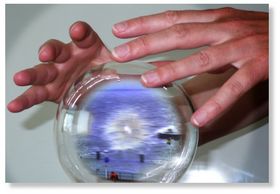Questions12
Questions
Whoever wishes to read the future
must leaf through the past.
André Malraux

What are the modern crystal balls of marine science? Which purpose do they serve?
A seemingly unpredictable system
Transitions in time and space characterise the Wadden Sea. The tides rise and fall twice daily. Caused by the phase of the moon, particularly high or low water levels overlay these changes. All of this is embedded into the general weather pattern. Moreover, global changes, such as sea level rise caused by climate change, affect the system.
The tidal flats are thus an example for a multifaceted system affected by various factors. It may well be that strong variations in single factors do not affect the system as a whole. On the contrary, a comparatively small change of one or several factors may possibly alter the system strongly. Scientists speak about non-linear relationships between individual parts of the system.
Environmental changes, initially perceived as marginal, can lead to an abrupt shift of the system. This may have dramatic effects on ocean currents, coupled weather patterns, the food web or species diversity, for example. The behaviour of these systems seems to be unpredictable. Still, such systems can be described increasingly better using computer-based models.
Models – why?
Where is our marine environment going? Which factors are altered or shaped through human action? How can these be influenced in such a way that the base for living in this environment is not going to be destroyed?
These are the key issues several modelling research groups of the ICBM deal with. However, they do not use the glassy spheres of medieval fortune-tellers. Their ‘crystal balls’ are modern computing systems. The scientists turn the pages of the past to be able to read the future with the help of highly developed computer simulations. The more complete the data material is that describes past and current developments, the more accurately the data can be reproduced with the help of computers. And the more likely predictions about the future can be made.
Extensive and complete data are an important prerequisite for improving and refining modelling systems. Such data have been collected for more than ten years with the help of the ICBM’s permanent Wadden Sea research platform and through the work of other internal and external research groups.
Modellers of the ICBM
For laypersons, extreme events such as harmful algal blooms and epileptic seizures appear to be very different. Still, it is useful to investigate substantial similarities with the help of models. The research group Theoretical Physics/ Complex Systems, headed by Prof. Dr. Ulrike Feudel, therefore addresses, amongst other things, the options to predict such events. In the case of algal blooms, this work may aid in minimizing the impact on human health and industry, whilst in the case of epileptic seizures, the work may aid in improving therapeutic options. Other models run by this research group deal with the degradation, build-up and description of marine sediments. They also investigate how suspended particles conglomerate and fall apart in the tidal currents of the Wadden Sea.
The research group Mathematical Modelling led by Prof. Dr. Bernd Blasius…

![[Translate to English:]](/f/5/_processed_/3/2/csm_ICBM-Logo-transparent-_91fe1c6774.png)